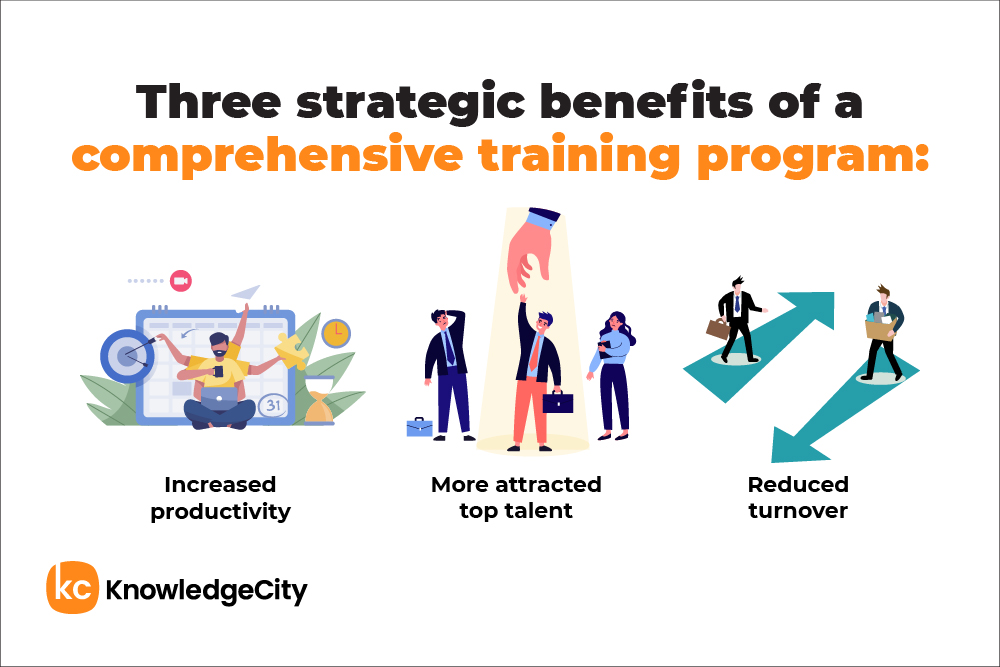Entry-level training programs can be costly, time-consuming, and tough to quantify. So why conduct one? Because the long-term benefit to your organization is worth the investment.
Providing entry-level training and development opportunities is more than just a nice perk to offer new career seekers. It’s a strategic investment in your company’s growth and success.
New college grads enter the workforce eager to learn and develop their skills, and training helps these business newbies feel more valued, confident, and engaged with your company from the get-go.
Not all entry-level training is created equal, however. To reap the greatest rewards, your program must provide plenty of useful information and education that employees will find meaningful. They should be able to immediately apply this knowledge to reach personal growth and success within your workplace.
Three Strategic Benefits
Organizations that offer beginners the comprehensive training they crave gain three strategic benefits:
Increased productivity. Developing workers’ problem-solving skills has an immediate, positive impact on productivity. Teaching your employees effective ways to handle common workplace issues doesn’t require overly complex training.
In six brief online sessions, for example, KnowledgeCity’s Fundamentals of Productivity will teach your employees how to efficiently create goals and to-do lists, prioritize, manage workflow, and avoid other common productivity pitfalls. By providing your new hires with this kind of training, you can create a productive environment where employees make the most of their jobs by making the most of their time.
Attracting top talent. Use your organization’s entry-level program as a strategic tool for attracting recruits who have the most sought-after technical talents and people skills. According to Cengage, approximately half of college graduates didn’t apply to entry-level jobs because they felt underqualified. They want on-the-job training so that they’ll be prepared.
Most companies don’t offer the kind of entry-level programs these new job seekers want. In weighing employment options, talented graduates are attracted to organizations that show a true commitment to developing employees’ professional skills and career goals.
Reduced turnover. Ongoing employee attrition is bad for business, causing constant time and money spent to recruit—and train—new employees to support your organization’s mission, vision, and values. Employees who feel supported in their career goals are more likely to be loyal and productive, which is why it makes sense to invest upfront in entry-level development.
Providing training instills new employees with a sense they are personally valued and supported, setting the stage for longer-term company loyalty, personal commitment—and less workforce attrition.
To Train or Not to Train?
Companies that opt out of entry-level training leave themselves vulnerable to negative, long-term ramifications. Allowing new hires to simply sink or swim without developmental support is much more costly to your organization’s growth and success than investing upfront in newcomers’ careers.
The proven benefits of helping new employees develop confidence, skills, and career goals make entry-level training a worthwhile, cost-effective move. Along with enhancing corporate stability, growth, reputation, productivity, and morale, early training boosts a company’s bottom line. But remember: The comprehensive quality of your entry-level training will determine its return on investment.
What to Include in an Entry-Level Training Program
Your entry-level program needs to cover more than the technical responsibilities newcomers have been hired to perform. New employees are excited to learn all they can about your organization, how to grow their skills, and what it takes to advance in your company.
Create training that provides useful, comprehensive tools and information that aids employees’ professional development. The training should also include specific insights about succeeding within the organization. Also, make it easy for your employees to access training courses without impacting their new job responsibilities.
In addition to formal training sessions, consider offering self-paced online and mobile options, so employees can complete courses on their own time. Bite-sized lessons that cover just one concept at a time are also helpful, allowing trainees to sandwich studying between workday duties. They’ll be more focused and increase their retention.
Essential Training Components
A Stellar Employee Orientation: Engage your new hires from the get-go by letting them know they are valued contributors to your company’s mission, vision, and values (and what those are). Show how they fit into the big picture of your organization’s success and your company’s commitment to their personal success.
When new employees feel welcomed and well-informed about the organization they’ve joined, you set the foundation for greater collaboration and long-term loyalty.
Soft Skills Training: Increasing data shows that sensational employees aren’t just great at the technicalities of their jobs, they’re also skilled communicators, collaborators, and team players. Excelling at such “soft” skills is often the true driver of long-term success within a company.
Because entry-level employees are new to the business world, they greatly benefit from developing their “softer” side. Your organization will reap the rewards of having more workers excel in critical skills like time management, communication, teamwork, emotional intelligence, and conflict resolution. Developing employees’ soft skills enhances team and individual performance while contributing to your company’s overall integrity, morale, and culture.
Technical Skills Training: Having excellent technical (“hard”) skills is the foundation for every employee’s success, so make sure new employees have the job-specific tools and training they need to perform their best. Ensure that newcomers are well-prepared for their assigned tasks and support their enthusiasm and efforts to learn new job requirements and technology advancements.
Providing employees the tools, knowledge, and support they need helps them proceed confidently in their jobs, along with boosting productivity and morale.
More Best Practices to Include
On-the-job training: Pairing essential orientation and skills training with on-the-job, peer-to-peer training has impressive results. Shadowing peers provides entry-level employees a firsthand chance to see soft skills in action and gain front-row insights about your workplace culture. In addition, this type of mentor/mentee training establishes valuable long-term partnerships for future learning and support.
Diversity & Inclusion Training: Successful companies understand the importance of promoting a safe and inclusive workplace. Providing Diversity and Inclusion Training for all employees will underscore your organization’s commitment to these values and give employees the tools and education they need to enhance and maintain a healthy work environment.
Presenting this training to new hires communicates your company’s expectations from the start and provides the tools for newcomers to carry them out.
Ongoing Training & Education: Your entry-level training program introduces employees to the benefits of developmental education. So it’s important to punctuate that precedent by offering ongoing training and education that helps employees grow their skills, meet career goals, and maintain your organization’s competitive edge. Employees are your company’s greatest asset, so investing in their ongoing success is important to corporate success.
How to Create Entry-Level Training
The idea of organizing a quality entry-level program for your company might seem daunting—but it doesn’t need to be. There are many existing resources to ease your efforts, including KnowledgeCity’s Learning Library of courses.
Start by listing the most critical components to include for your training, then go online to research existing courses on those topics. Choose courses that best suit your organization’s needs, then customize your presentations with specific details and insights about your company.
Here’s just a sample from KnowlegeCity’s courses that will make it easy to grow your entry-level employees’ organizational aptitude and professional skills:
First Development Steps: Learning the first steps toward developing your team. This course explores the building blocks of an organizational strategic plan, including how to develop the focus, goals, and mission to achieve a competitive advantage and chart a path forward.
Your employees will learn how to:
- Articulate a vision and set strategic focus areas
- Set strategic goals and link them to a vision
- Adopt strategic clarity and minimize complexity
- Communicate strategic goals
Confident Communication: How to communicate more confidently in the workplace. As one of the all-important soft skills, communication is key to building great working relationships and leading others. This course covers various types of communication, including verbal and nonverbal.
It also features ways to overcome anxiety, boost self-confidence, and improve communication skills in the workplace and beyond. Nonverbal cues, public speaking, and managing difficult conversations are all addressed.
Your employees will learn how to:
- Reframe their inner dialogue
- Identify their communication strengths and weaknesses
- Use the three Vs of communication
More Resources
Knowledge has a variety of courses to help you build your comprehensive entry-level training program. Check out our full library of courses here, including these ready-made lessons to help get your program started.
Subscribe to Our Newsletter
Join 80,000+ Fellow HR Professionals. Get expert recruiting and training tips straight
to your inbox, and become a better HR manager.

 KnowledgeCity
KnowledgeCity 













